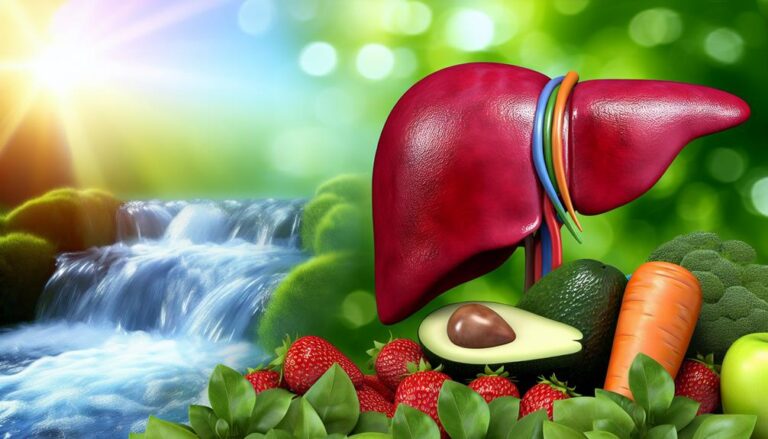
senior planet fitness videos;senior fitness exercises routines;senior fitness test protocol;senior fitness youtube;free senior fitness workouts

You might not realize that your liver enzymes are constantly at work, breaking down the substances you consume and protecting your body from toxins. These enzymes operate in two distinct phases, each with a specific role in detoxification. Understanding how these phases function can reveal much about your overall health and how your body handles various substances. But what happens when these enzymes don’t perform at their best, and what factors influence their activity? Exploring these questions can shed light on the importance of liver health.
Listen to this Article Summary
Key Takeaways
- Liver enzymes, primarily Phase I and II, are crucial for modifying and conjugating toxins for safe excretion from the body.
- Cytochrome P450 enzymes metabolize drugs and toxins, exhibiting genetic variability that affects individual detoxification capabilities.
- Glutathione transferases help transform toxic compounds into water-soluble forms, aiding in their elimination and protecting against oxidative stress.
- Various factors, including diet, lifestyle, and environmental exposure, significantly influence liver enzyme activity and detoxification efficiency.
- Regular liver function testing is essential for monitoring enzyme levels and detecting potential liver dysfunction early.
Overview of Liver Enzymes
Liver enzymes play an essential role in the body’s detoxification processes, acting as catalysts that facilitate biochemical reactions necessary for metabolizing drugs, toxins, and other compounds.
Understanding liver function is important, as it directly impacts how effectively these enzymes operate. Enzymes in the liver are primarily categorized into two groups: phase I and phase II enzymes.
Phase I enzymes, such as cytochrome P450, modify compounds through oxidation, reduction, or hydrolysis, preparing them for further transformation.
Phase II enzymes, on the other hand, are responsible for conjugation reactions, which enhance the solubility of these compounds, making it easier for the body to excrete them.
Enzyme regulation is essential for maintaining homeostasis in the liver. Factors like genetics, diet, and environmental exposure can influence the activity levels of these enzymes.

For instance, certain foods can either induce or inhibit enzyme activity, altering the metabolic pathways and affecting how efficiently the liver detoxifies substances.
Key Enzymes in Detoxification
To understand detoxification, you need to focus on key liver enzymes like Cytochrome P450 and Glutathione Transferases.
Cytochrome P450 enzymes are essential for the oxidation of a wide range of substances, while Glutathione Transferases play an important role in conjugating toxins for easier excretion.
Together, these enzymes greatly enhance your liver’s ability to process and eliminate harmful compounds.
Cytochrome P450 Enzymes
Cytochrome P450 enzymes are essential players in the body’s detoxification process, responsible for metabolizing a wide range of substances, including drugs, environmental toxins, and endogenous compounds.
These enzymes exhibit diverse cytochrome functions, which facilitate their role in transforming lipophilic compounds into more hydrophilic metabolites that can be easily excreted.

You’ll find that enzyme interactions within the P450 family can yield different metabolic pathways, impacting drug efficacy and toxicity.
Consider the following key aspects of cytochrome P450 enzymes:
- They’re involved in the oxidation of various substrates.
- They exhibit genetic variability, leading to differences in drug metabolism among individuals.
- They can activate pro-drugs, converting them into their active forms.
- They may produce reactive intermediates, which can cause cellular damage.
- Their activity can be influenced by external factors like diet and environment.
Understanding these enzymes is vital for appreciating how your body detoxifies and handles chemical exposure.
Glutathione Transferases Role
Glutathione transferases (GSTs) play an essential role in the detoxification process by catalyzing the conjugation of glutathione to various substrates. This enzymatic activity facilitates the transformation of toxic compounds into more water-soluble forms, enhancing their excretion from the body. By promoting glutathione conjugation, GSTs effectively mitigate the effects of harmful xenobiotics and endogenous toxins.
You’ll find that GSTs are important components of the body’s antioxidant defense system. They not only detoxify reactive electrophiles but also protect cellular components from oxidative stress. The conjugation reaction often results in the formation of non-toxic metabolites, which can be readily eliminated via urine or bile.
Moreover, GSTs exhibit a broad substrate specificity, allowing them to interact with a wide range of toxins, including heavy metals, carcinogens, and pharmaceutical agents. Their functionality is essential for maintaining cellular homeostasis and preventing the accumulation of harmful substances.

Mechanisms of Action
Understanding the mechanisms of action for liver enzymes in detoxification reveals their vital roles in metabolizing xenobiotics and endogenous compounds. These enzymes facilitate complex metabolic pathways, enabling the body to neutralize and eliminate harmful substances effectively.
The primary processes include phase I reactions, where oxidation, reduction, or hydrolysis modifies compounds, and phase II reactions, where conjugation enhances water solubility for excretion.
Key aspects of liver enzyme action include:
- Enzyme regulation: It’s essential for maintaining balance in metabolic pathways.
- Cofactors and coenzymes: Important for optimal enzyme function during detoxification.
- Substrate specificity: Different enzymes target specific compounds, ensuring efficient processing.
- Induction and inhibition: Certain substances can increase or decrease enzyme activity, affecting detoxification rates.
- Genetic variability: Individual genetic makeup can influence enzyme efficiency and effectiveness in metabolizing toxins.
Factors Affecting Enzyme Activity
The efficiency of liver enzymes in detoxification can be markedly influenced by various factors that affect their activity. One vital component is enzyme regulation, which involves the modulation of enzyme activity through various mechanisms, including allosteric regulation, covalent modification, and feedback inhibition. These processes guarantee that enzymes operate efficiently according to the body’s needs.
Diet impact also plays a significant role. Nutrient availability can either enhance or inhibit enzyme function. For instance, certain vitamins and minerals serve as cofactors, essential for peak enzyme activity. A deficiency in these nutrients can lead to suboptimal detoxification processes.
Additionally, the presence of specific dietary compounds, such as polyphenols or flavonoids, can either support or hinder enzyme activity.

Furthermore, the consumption of certain substances, like alcohol or recreational drugs, can induce or inhibit the production of specific liver enzymes, altering their overall effectiveness.
Your lifestyle choices, including diet and substance use, directly affect the liver’s ability to detoxify. Understanding these factors allows you to make informed decisions to promote effective liver enzyme activity and, consequently, better detoxification processes.
Supporting Liver Health
Supporting liver health is vital for maintaining ideal detoxification processes and overall well-being. To optimize liver function, you should focus on specific lifestyle choices and dietary habits that promote its health. Incorporating liver friendly foods and ensuring adequate hydration can greatly enhance your liver’s ability to detoxify effectively.
Consider the following strategies to support liver health:
- Consume liver friendly foods: Incorporate leafy greens, cruciferous vegetables, and whole grains.
- Stay hydrated: Drink plenty of water to support metabolic processes and flush out toxins.
- Limit alcohol intake: Excessive alcohol can overwhelm your liver, so moderation is key.
- Engage in regular exercise: Physical activity improves circulation and aids in detoxification.
- Prioritize sleep: Adequate rest is essential for liver regeneration and overall health.
Signs of Liver Dysfunction
You may notice several common symptoms if your liver isn’t functioning properly, such as fatigue, jaundice, or unexplained weight changes.
Recognizing these signs is vital, as they can indicate underlying liver dysfunction that requires immediate attention.

Regular testing of liver enzymes can provide essential insights into your liver health and help detect issues before they escalate.
Common Symptoms Experienced
While liver dysfunction can manifest in various ways, recognizing the common symptoms is essential for early intervention. Understanding these signs enables you to pursue timely symptom management, which is fundamental for maintaining liver health.
You might experience the following symptoms:
- Fatigue: Persistent tiredness despite adequate rest can indicate liver overload.
- Jaundice: A yellowing of the skin and eyes often results from bile duct obstruction or liver disease.
- Abdominal Pain: Discomfort or swelling in the upper right abdomen may signal liver inflammation or enlargement.
- Dark Urine: Urine that appears darker than usual can indicate elevated bilirubin levels, a byproduct of liver dysfunction.
- Nausea and Vomiting: Frequent digestive issues can stem from the liver’s impaired ability to process toxins.
Being aware of these symptoms allows for early detection, which can greatly improve treatment outcomes.
If you notice any of these signs, consulting a healthcare professional is essential. Early detection not only aids in effective symptom management but also helps prevent further complications related to liver dysfunction.
Importance of Regular Testing
Regular testing for liver function is crucial in identifying potential dysfunction before it progresses to more severe conditions. By routinely monitoring enzyme levels through blood tests, you can gain important insights into your liver health.

Testing frequency should be tailored to individual risk factors, such as lifestyle changes, dietary impacts, and genetic factors that may predispose you to liver issues.
Utilizing various assessment methods, such as liver function tests (LFTs), allows healthcare providers to evaluate significant enzymes like AST, ALT, and ALP. Anomalies in these enzyme levels can signal underlying conditions, prompting timely intervention.
Regular health monitoring not only aids in early detection but also serves as a critical tool for risk assessment, helping you make informed decisions about lifestyle modifications.
For instance, if your results indicate elevated enzyme levels, you might consider dietary changes or increased physical activity to mitigate further liver stress.
Conclusion
In the intricate dance of detoxification, liver enzymes act as skilled dancers, guiding toxins and drugs to their final bow. By understanding their roles and the factors that influence their performance, you can become an informed conductor of your liver’s health orchestra. Nurturing these enzymes through a balanced diet and lifestyle choices guarantees they shine brightly, preventing the shadows of dysfunction from creeping in. Ultimately, a well-tuned liver is your best ally in maintaining overall wellness.





